Non-Revenue Service Cars
12345
12345
|
What was the Tare of these boxcars. 8 or 10 tons?
UpSideDownC
in New Zealand |
|
Chris the folio says the capacity is 28,000 with a light weight of 17,100.
Keith Hayes
Leadville in Sn3 |
|
In reply to this post by Keith Hayes
Almost done.

Keith Hayes
Leadville in Sn3 |
|
I may have shared that I am working towards my NMRA MMR credential. This has caused me to think about and approach modelling a bit differently. That and I have been watching a lot of airplane and armor videos where the modelers applied undersprays of different colors with light overcoats to achieve some more nuanced shadowing and weathering effects.
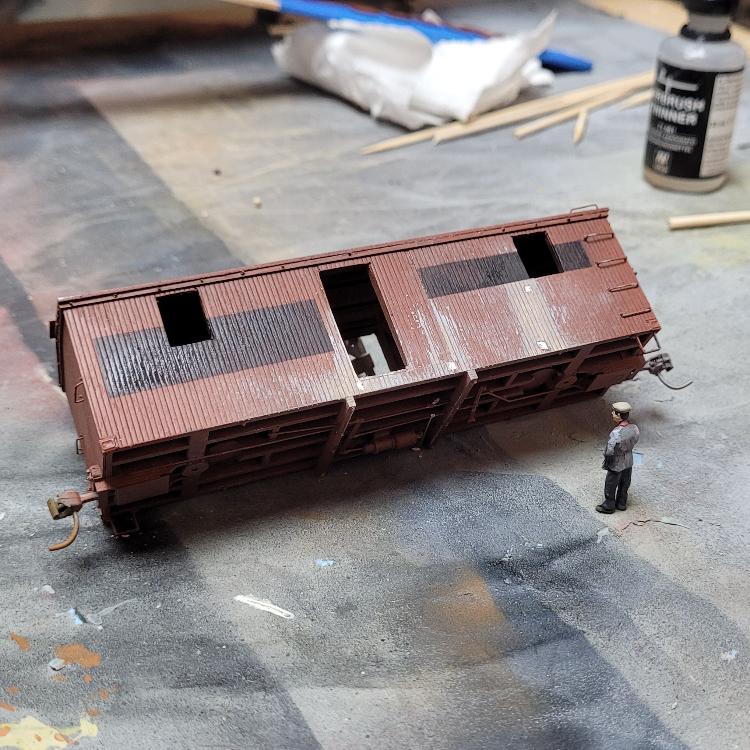 The Leadville Shops car has some location marks for door hardware that are not needed on a Water Service car. Though I initially overlooked these, they bothered me and I filled them in with putty fixed with a drop of CA. It also occurred to me that these 27' cars might have been patched for UP service, similar to the cars at St. Elmo. For those gentle readers who think patching is a new thing, UP first did this when it assumed control of the DSP&P, painting out the old letters with black patches, and new UP lettering on top. At least that is my story. 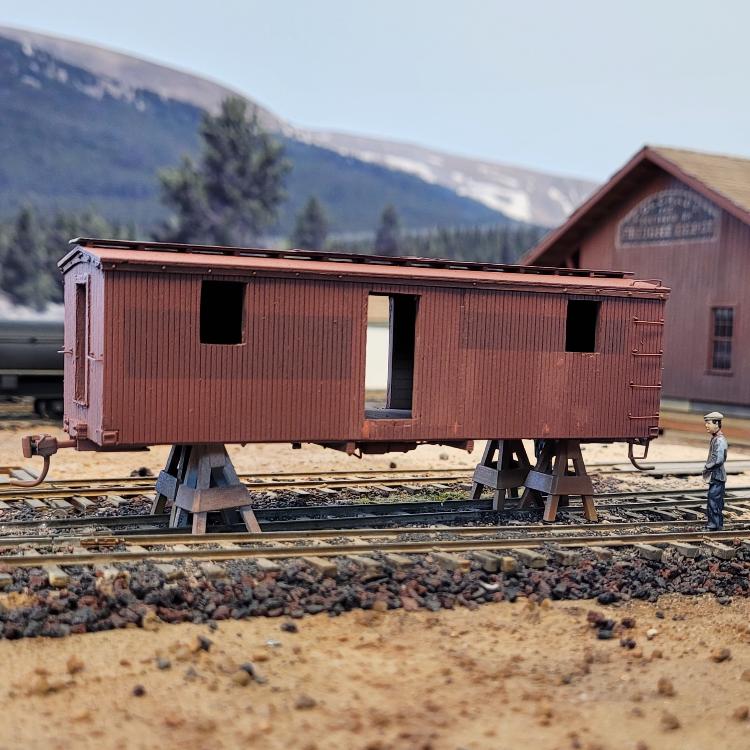 Here is the final result. I also dusted on some black for shadows at the roof trim. A coat of gloss will follow and some decals.
Keith Hayes
Leadville in Sn3 |
|
Neat technique, and great outcome!
|
|
Thank you Jeff. More progress.
 At Jim's suggestion, I procured some HO block lettering from Microscale. The large 'C&S' and spelled out name are from this set; the end lettering is from an S scale set as are the numerals in Roman. The second car will be 080.
Keith Hayes
Leadville in Sn3 |
|
In reply to this post by Keith Hayes
It also occurred to me that these 27' cars might have been patched for UP service
According to Randy Hees, the black rectangles weren't "patches" to just cover old South Park lettering. The black backgrounds were a standard UP system painting convention for house cars in the 1880s, as were the white fascia boards. 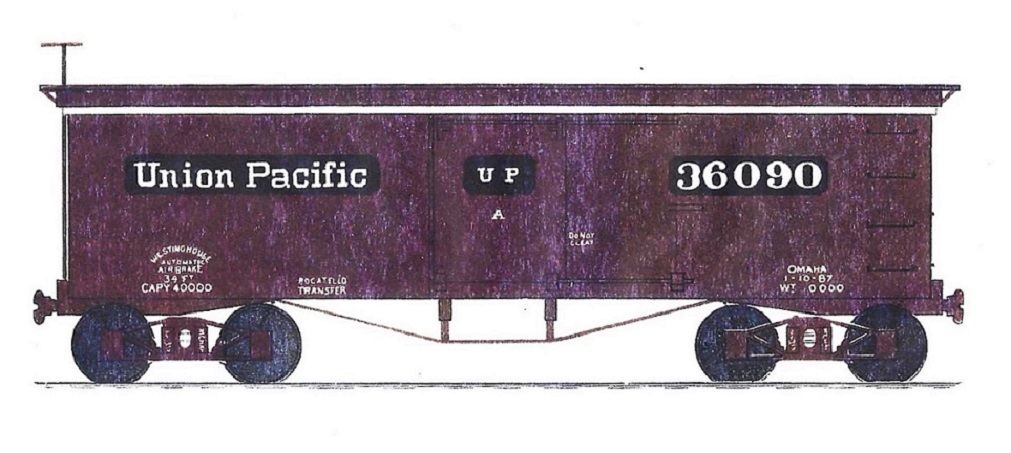 Standard UP paint card from Sherwin Williams Like Keith, I always understood that those black rectangles, under the reporting marks and numerals, were paint masks, used to obliterate the older, pre-1885 lettering (i.e. DSP&P, C.C., Kansas Central, Utah and Northern, etc.). But according to Randy's research, they were a standard UP system painting convention, also applied to newly constructed cars at the factory, when built. Keith's technique is interesting, as I plan to have a couple of 27 foot boxcars still in UPD&G and DL&G livery: 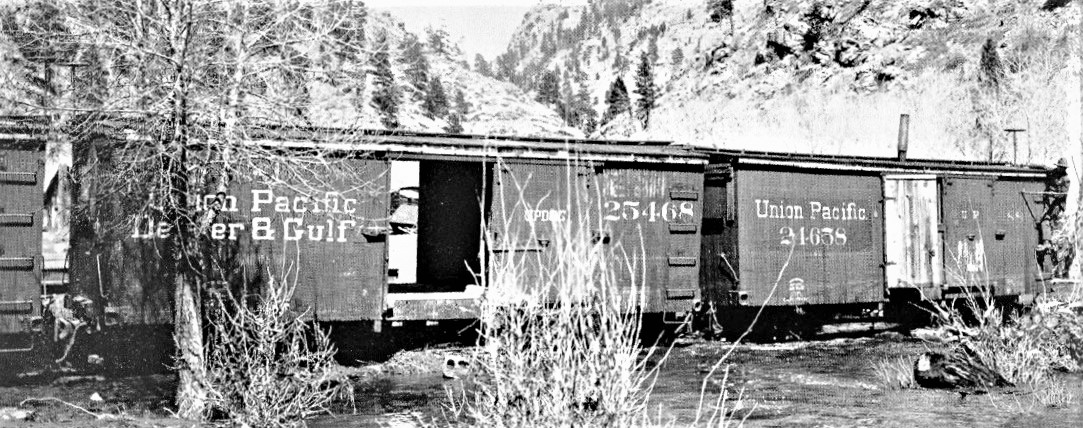 The UPD&G cars had to have a left side rectangle just for the road name, with smaller black rectangle on the right for the car number, while the DL&G car to the right, had a single left faded black rectangle for UP road name and car number. The original DSP&P 800 series car number is visible under the faded boxcar red at the right end of the car. Another technique that I want to try is partial re-sheathing, with fresh paint just over the new lumber: 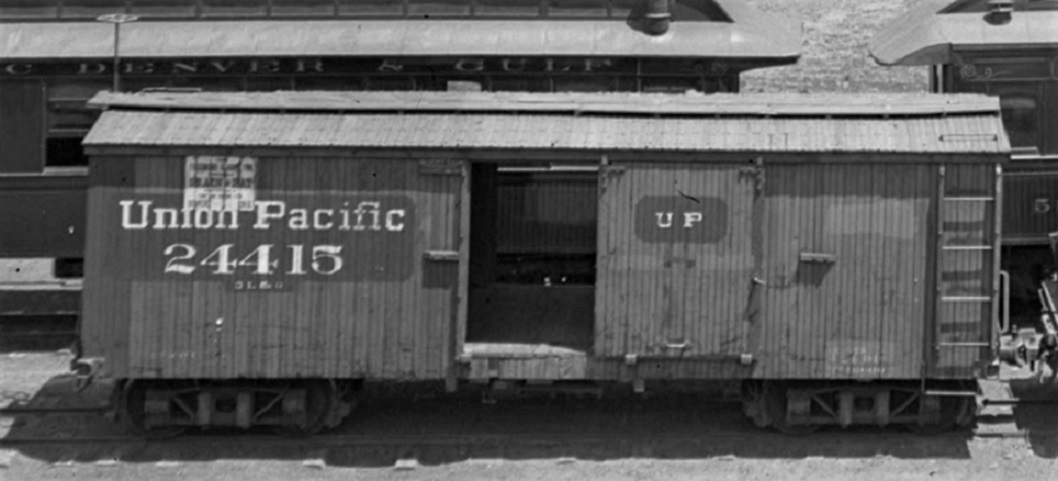 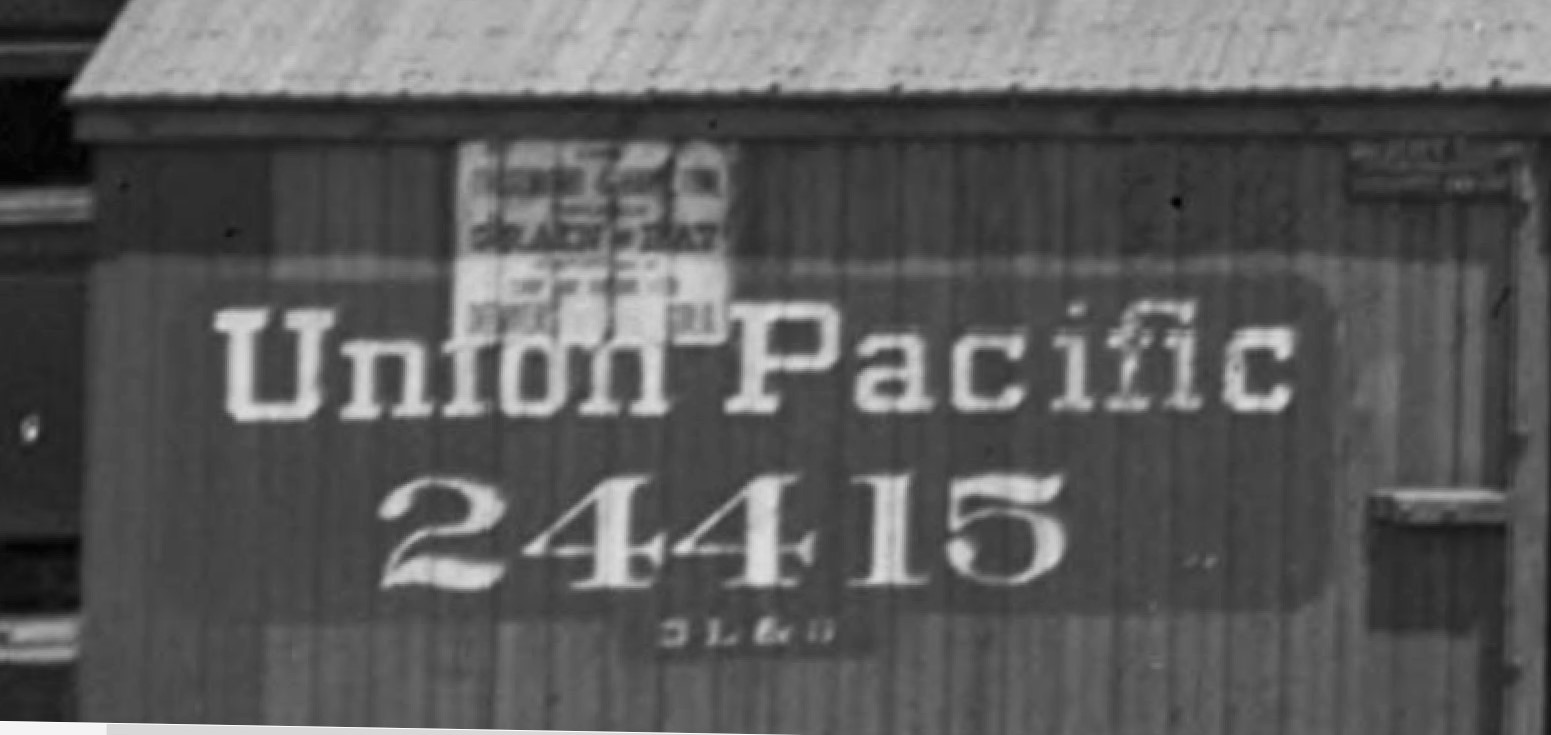 Note that the left three sheathing boards have been recently replaced, with fresh paint applied to those three center-groove boards. The black rectangle seems to be touched up where it crosses the new paint. Note also the freight car red true paint "patches": On the right side (possibly covering the old South Park number), the center of the door and the lower right side, applied as a background for updated weight and dimensional data. I guess with Keith's method, I'll need to paint the black rectangles, mask them off. Then use varying shades for freight car red for the at least three visible shades on the car sides. Much masking! And then there are chalk marks:  BTW, some nice chalk mark decals are available at http://nationalscalecar.com/product/d135-freight-car-chalk-markings/ I always learn something new about model building from Keith's posts. 
Jim Courtney
Poulsbo, WA |
|
In reply to this post by SteveG
Here is of 068 in HOn3 I built years ago. The lettering I copied from a pic of 051.
As I model 1929 it had received a new coat of paint. I don't remember who's kit I used. Ken Martin 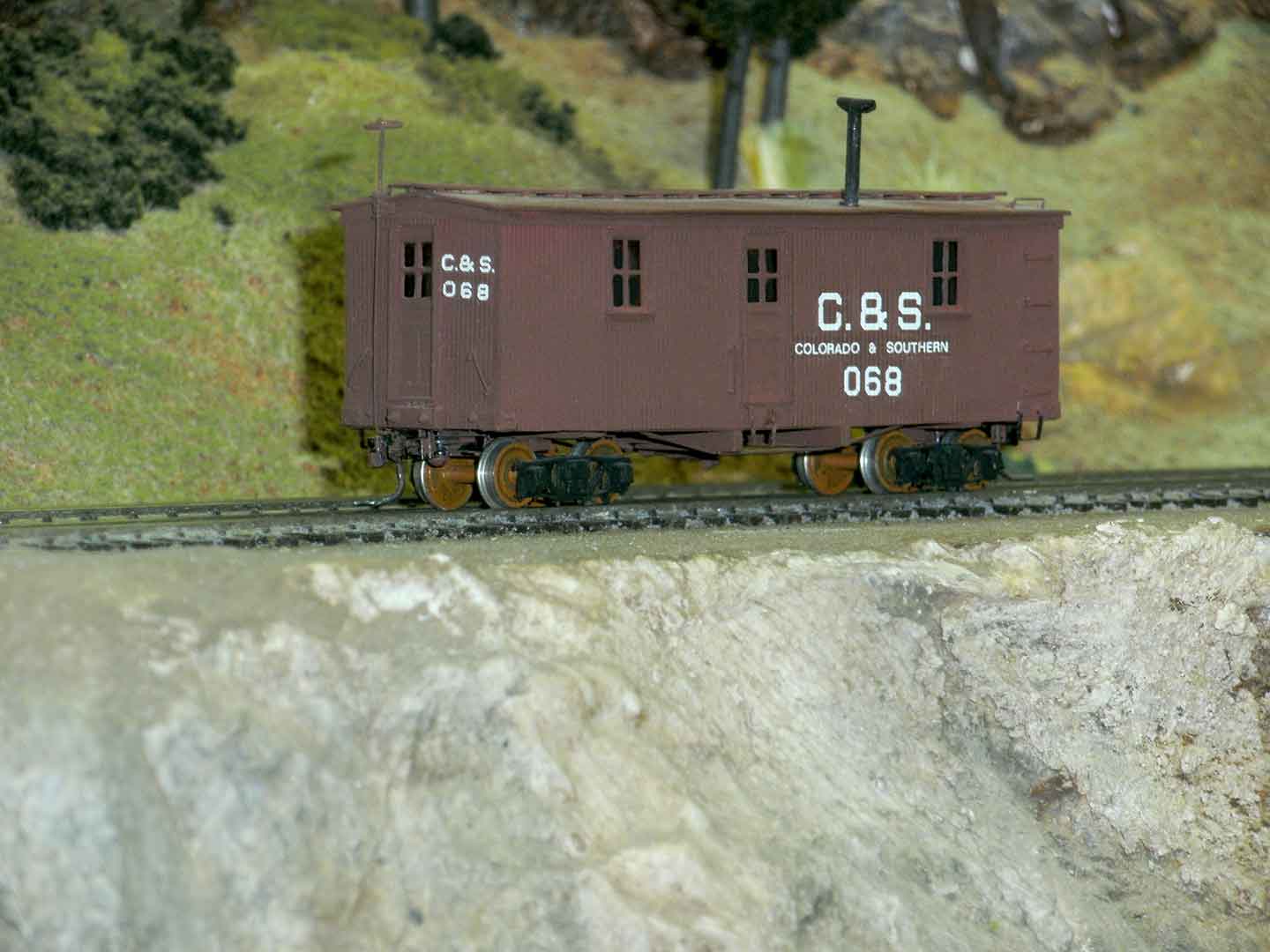 |
|
In reply to this post by Jim Courtney
Heck, Jim, I am always learning something from YOU! I noticed the chalk marks on a couple of your recent builds and had not gotten around to asking you about them. I ordered two sheets and expect my cars will be 'chalked up' shortly! Thanks!
For my UP black panels, I quickly eyeballed the patches from the St. Elmo photo and got to work. I am impressed that the UP standard has rounded corners. Hmm. Long time readers know of my fondness for a photo of 73 eastbound with a short freight at Michigan. This image has a coal with block lettering that survived into the 20s or 30s. I posit that a number of lettering styles co-mingled to the end of the line. 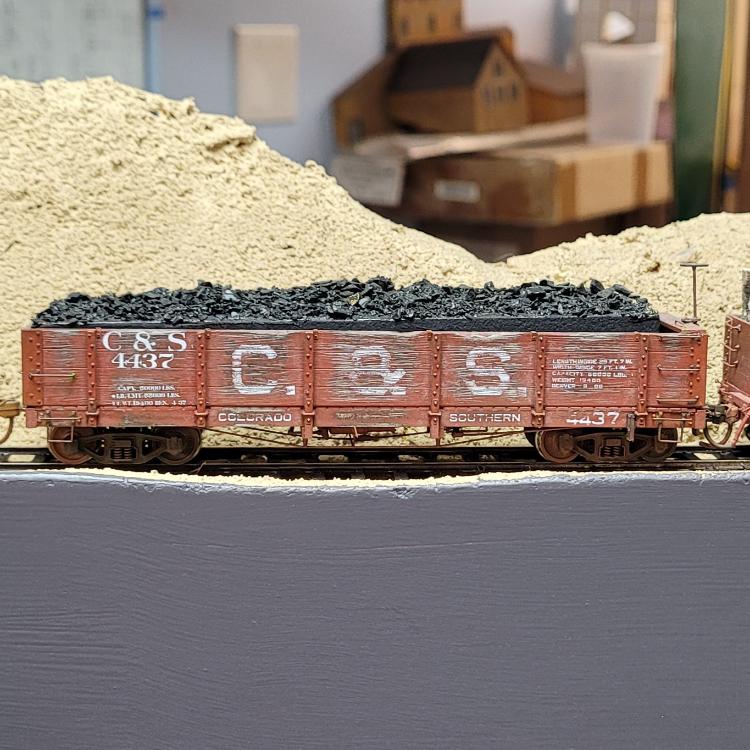 This Phase 3 coal has the block lettering with new Roman reporting marks.  This Phase 1 coal has a hybrid scheme: The Colorado Road logo has vanished and a quick reletter was done in Denver or Como. The faded logo was rendered with white water color pencil.  Perhaps the easiest scheme is what I call the 'eclipse' herald: the circular trademark sans lettering, which seemed to wash off. If your decal set has a 2-part decal with a black circle and white lettering, this is easy to create. Otherwise you will need a steady hand to cut a small circle mask or use a Crickut. 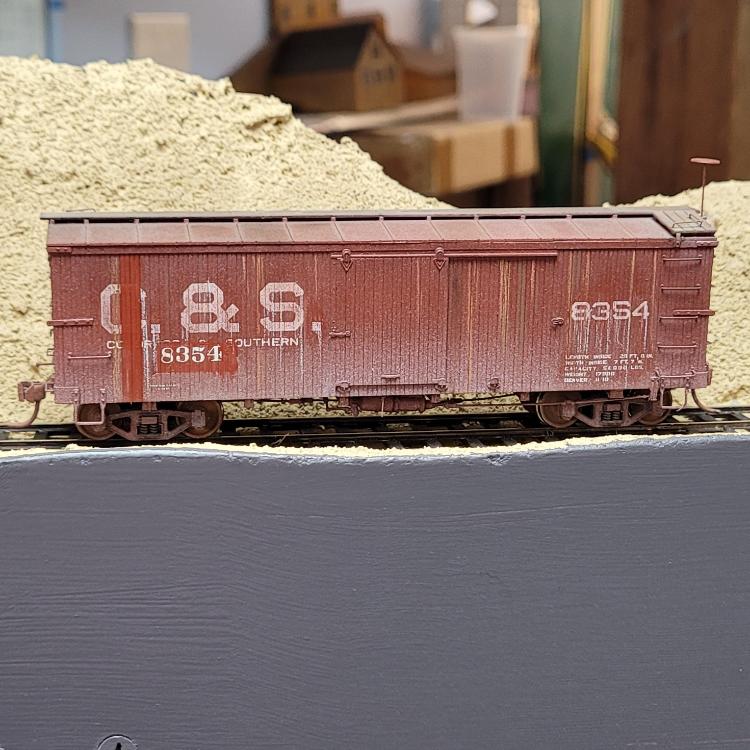 Last is a Phase3 box with block lettering, a path and some boards replaced. Very easy to accomplish with some quick masking! Individual board weathering is accomplished with water color pencils. On Jim's example above, I bet that car was in a coupling accident and had the draft gear an/or end beam replaced. This would involve removing some end siding to uncover the endbeam. Something to consider for a future model: tape off the last few boards on each side before a light spray of white and your car has just visited the shop!!
Keith Hayes
Leadville in Sn3 |
|
In reply to this post by Jim Courtney
My turn. One well-known car that had black patches was the Greeley Salt Lake & Pacific caboose 026552, a UP-built 1880 24' Colorado Central car modified ca 1885/1886. A slight stretch but it feels a good place to point out the differences these markings took.
For six decades artists and plan makers have repeatedly presented the side lettering inside a black band running the full length of the side. In fact, it didn't. This is the car in the late 1880s at Sunset. Note the "Colorado Central" the "C C" on the door and the "026552" all float in their own individual rectangles. 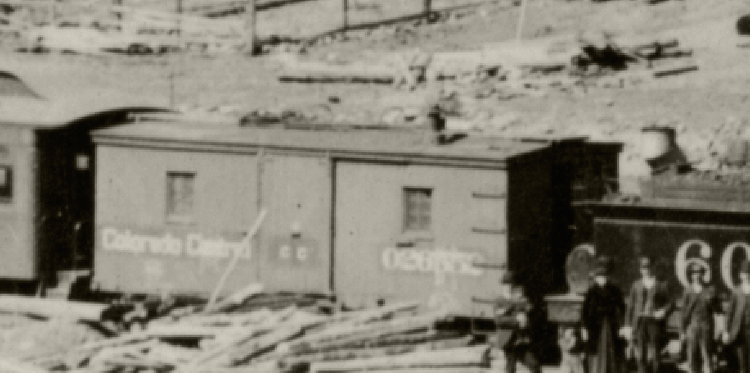 The end of the car looked like this. 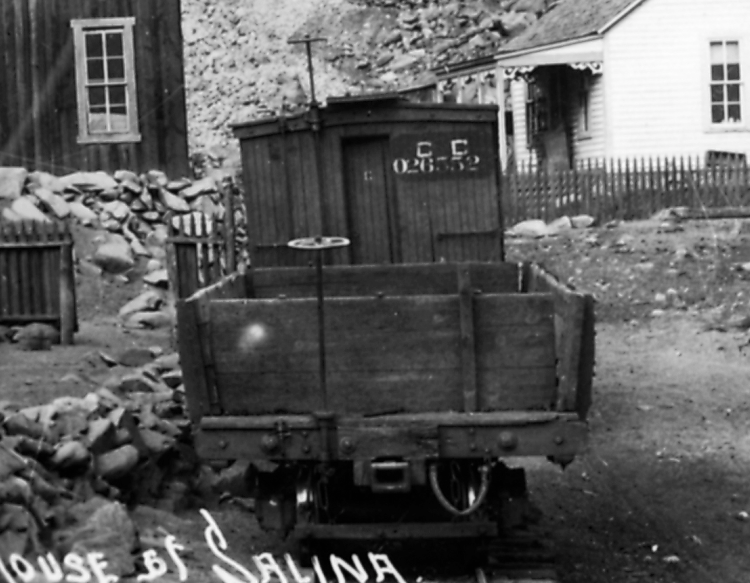 This is on the spur at Salina, also known as Gold Hill, in the late 1880s. Note the patch for the lettering and number but also the "C" on the end door--which does not appear to have a backing patch. It's predecessor caboose, 01542, predated the UP renumbering effort and never appears to have been "patched." This is about halfway up Boulder Canyon, about a mile and a half west of Boulder, at a location known as Maxwell Pitch around 1884/1885. 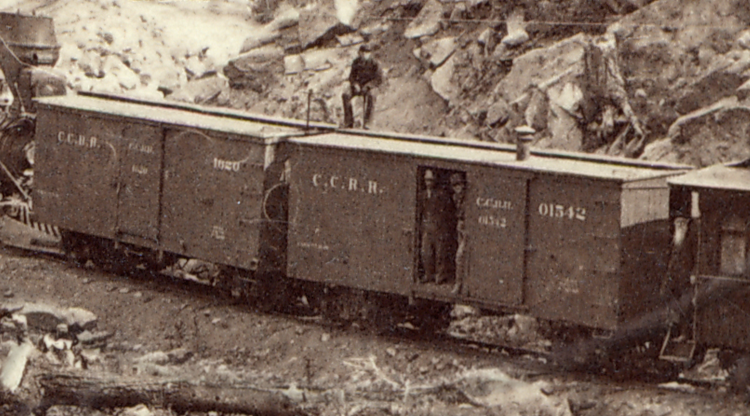 The car behind it, 1620, was a sister boxcar to 026552 and shows how those UP cars were originally lettered. They painted out the old markings in body color when the car was converted to a caboose and the patches are intentionally placed for legibility.
Dave Eggleston
Seattle, WA |
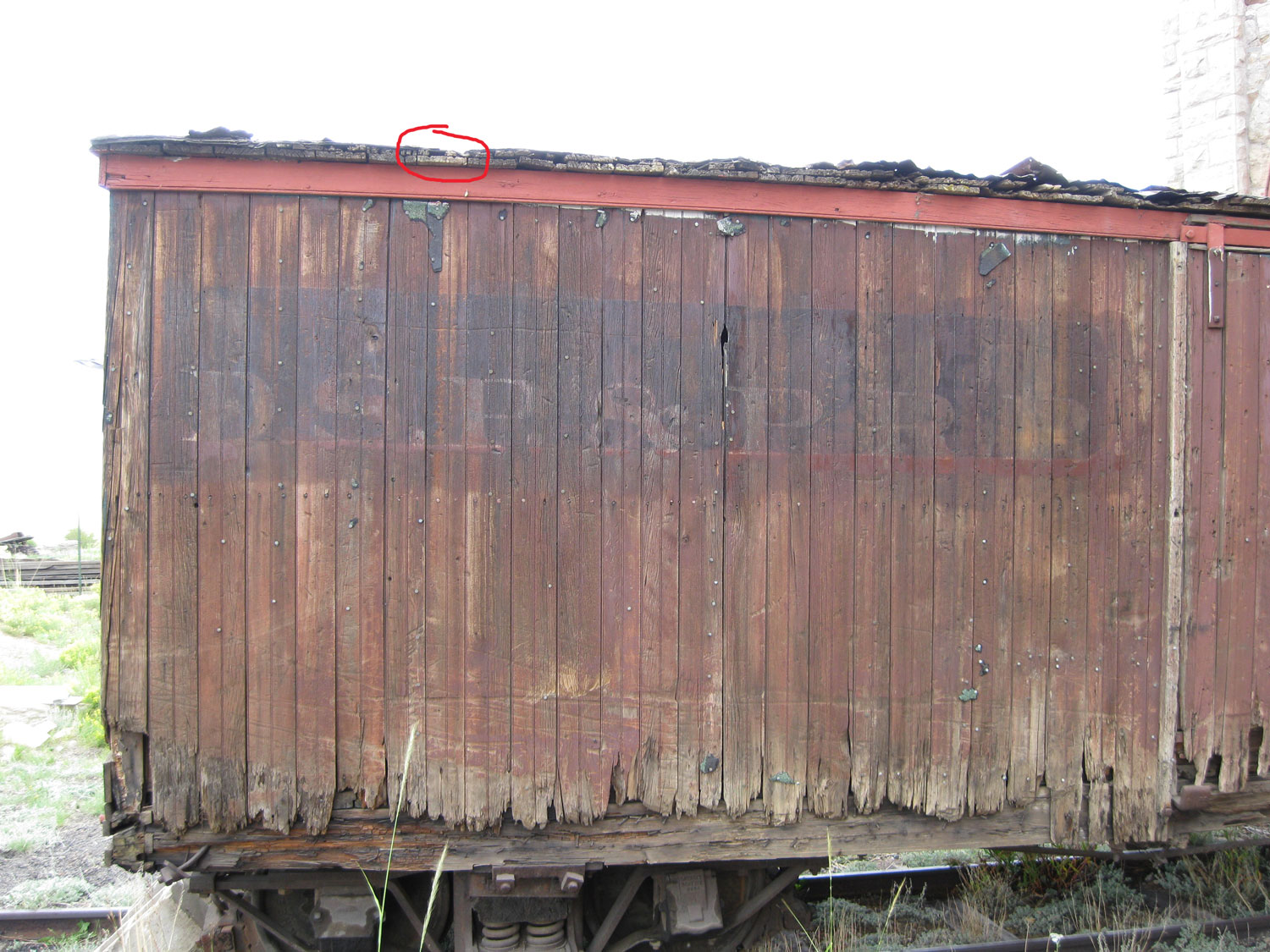
Doug Heitkamp
Centennial, CO |
|
This post was updated on .
Doug, that siding is too rough for my taste!
 Interesting that the black patch does not/ did not entirely cover the DSP&P letter, which incidentally included a red drop shadow!! Also, looks like there were two patches--maybe a smaller one for Union Pacific, just like the paint card--and maybe a larger one for the UPD&G? Where is/ was this car? Based on the degraded siding along the bottom of the car, I venture this was sitting in the dirt?
Keith Hayes
Leadville in Sn3 |
|
Keith,
This is the boxcar that was in Cardinal. I believe you are correct that it was on the ground, but it was covered with roofing material which helped save the siding. I took this picture a few years ago after the car had been moved to Como. Enjoy!
Doug Heitkamp
Centennial, CO |
|
In reply to this post by Keith Hayes
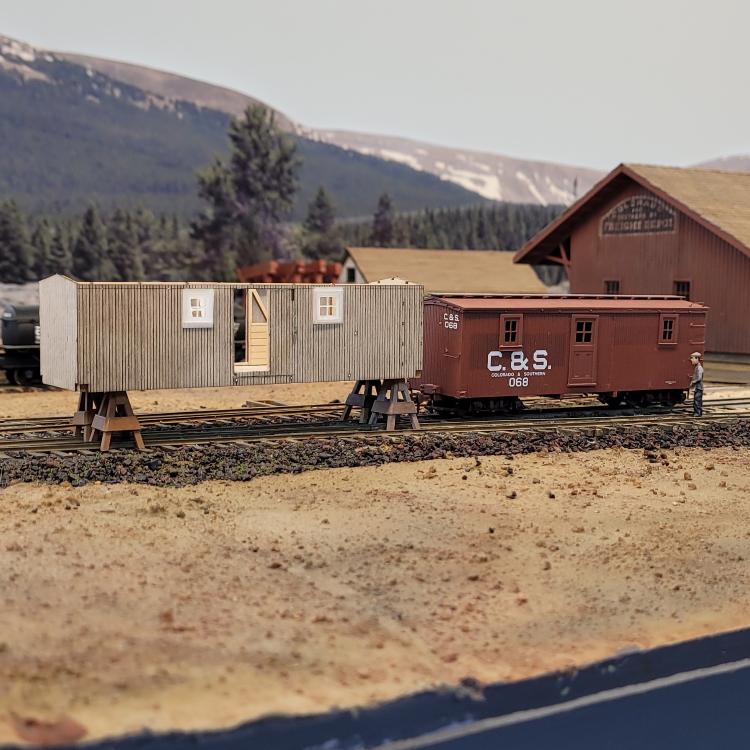 080 and 068. I made a lot of progress on this project this weekend. The base model is a Leadville Designs 27' boxcar. Jim provided the folios for the two cars. I 3d printed the door and windows. I deviated from the directions and assembled the sides flat, installed the side doors in the precut openings and laid out the new openings.
Keith Hayes
Leadville in Sn3 |
|
Keith,
since you're modelling the late 30's, you could realistically get away with placing an old carbody on the ground: surely there was at least one in Nth Leadville(or could be  ). ).
UpSideDownC
in New Zealand |
|
Indeed, Kokomo could use a couple of decrepit car bodies behind that nice depot.
Jim Courtney
Poulsbo, WA |
|
Jim, years ago I got one of the Banta carbody kits and got so excited as I assembled it I didn't give a thought about how to glaze the windows. The carbody moved around the layout with a tendency to find locations towards the rear. I spied your model in C&S lettering and the thought occurred I could both glaze the windows and experiment with some vintage lettering by cutting the model in half.
I started with a fresh coat of paint. Then I applied the DSP&P decals from my. 27' boxcar kit. 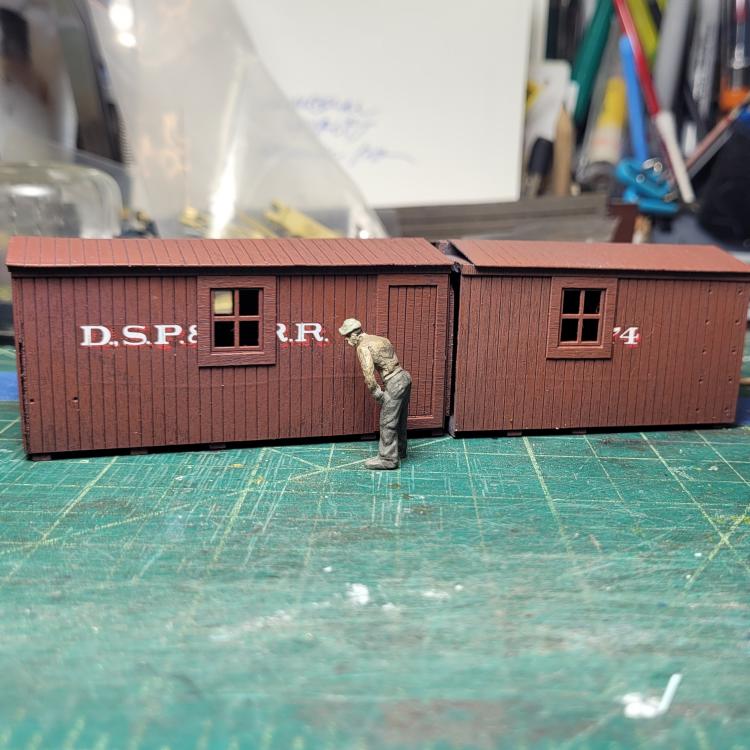 When I had the decals settled into the boards, I added drop shadows with red acrylic. Next came an overspray of black for a UP patch. Finally came an overspray of red. 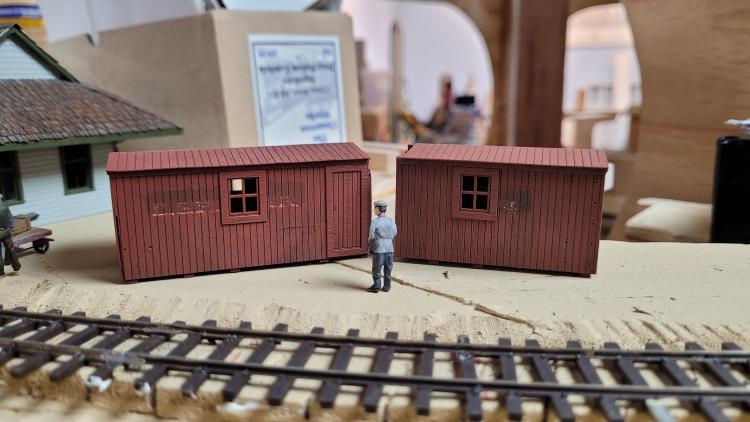 I still have to glaze those windows though. These will snuggle up next to the Kokomo depot.
Keith Hayes
Leadville in Sn3 |
|
In reply to this post by Keith Hayes
Making progress. I finished all the jewelry on both cars including coupler chain lift bars. For 080 I wanted to paint the fascia board white, so I did!
 Sorry for the random photo. I realized that I am working with acrylic, so I could go ahead and spray the top coat. I used half rust and half brown, which emulates Mike Trent's patented C&S freight car red recipe. Multiple light, thin coats is the key.  Here is where things stand now. I got the trucks on 068, but am still drilling holes and assembling the trucks for 080. I liked the white fascia and was sorry it only lasted an hour or so. One more reason to model The South Park/ Clear Creek lines: they had styling paint and lettering schemes!   Postscript: based on the coupler height, I had to increase the car height about 0.10" over just mounting the car directly on to the trucks. I found some 0.10" styrene and cut a chunk. Not wanting the car to rock, I made some small buffers of 0.03" square stock and cemented these at the ends. The trucks would now be high enough to rotate about, so I made a stop from 1/4" x 0.02" material and glued it to the side. Everything was sandes square, primed and painted black. The car now sits kind of high as the 1883 UP boxcars did.
Keith Hayes
Leadville in Sn3 |
|
Here's where things stand today.
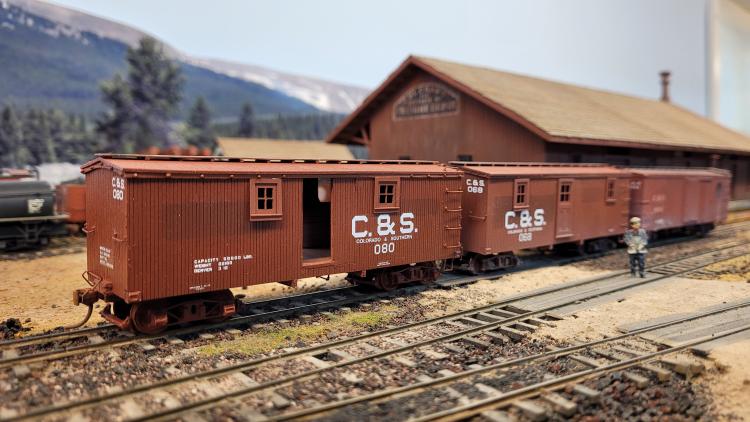 If you look closely you can see traces of the white fascia on 080. Out of the box, the cars are very light. I will end up adding about 1/2 ounce to each. Almost time to glaze and install the windows and doors and apply final weathering. Oh, and 080 gets a tool box on the roof. And smoke jacks--these are in fabrication now.
Keith Hayes
Leadville in Sn3 |
|
Great job, Keith! So nice to see these "invisible" cars make an appearance on layouts.
Dave Eggleston
Seattle, WA |
«
Return to C&Sng Discussion Forum
|
1 view|%1 views
| Free forum by Nabble | Edit this page |

